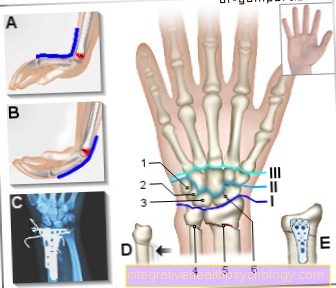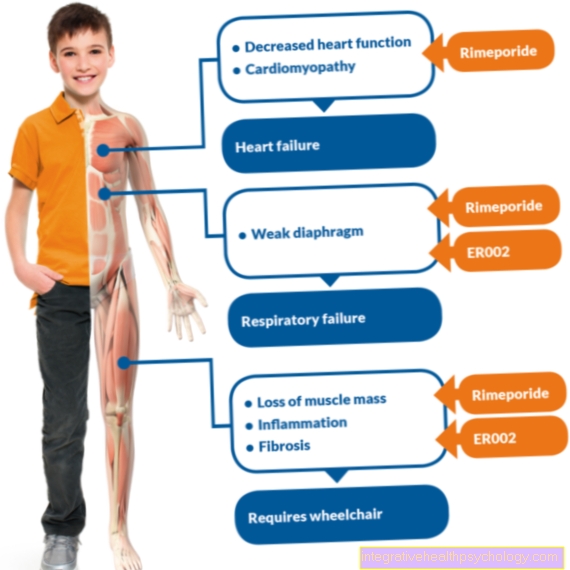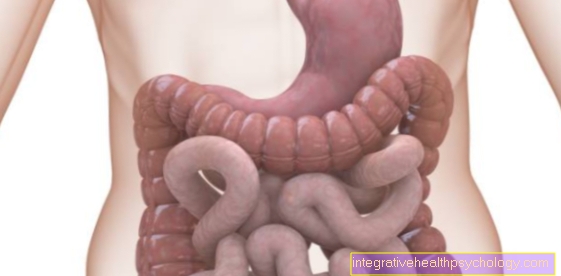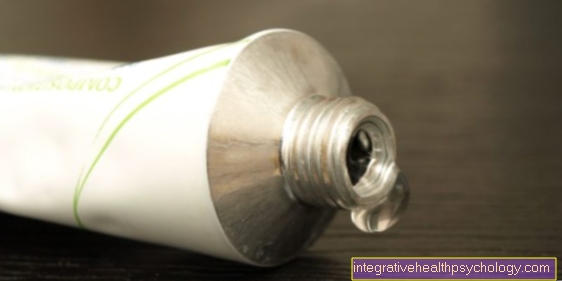Symptoms of bronchitis
introduction
Acute bronchitis is one of the most common diseases of the lower respiratory tract and usually describes inflammation of the bronchi caused by viruses (bronchitis) or the windpipe (Tracheitis).
In some cases, both levels, i.e. the bronchi and windpipe, can also be affected. This type of inflammation is known as tracheobronchitis.

What are the symptoms of bronchitis?
The symptoms of acute bronchitis differ depending on the pathogen. In most cases, adenoviruses or rhinoviruses are the cause of acute bronchitis.
The disease generally begins with a dry, barking cough. The inflammation of the windpipe can cause a severe sore throat. If the larynx is also inflamed, the patients get hoarse speech. After a few days, the dry cough turns into a productive cough with congested bronchi and sputum.
In addition to these specific symptoms, the general symptoms such as fever, fatigue or body aches appear.
If a bacterial superinfection develops on the bottom of a viral infection, the color of the sputum changes to greenish and the amount of sputum increases significantly. Complications arise when the bacterial infection turns into pneumonia.
Chronic obstructive pulmonary disease (COPD) in the sense of chronic bronchitis is mainly associated with the symptom of shortness of breath. After a strong cough and sputum in the morning, many patients are symptom-free for the rest of the day, provided that the COPD is not very advanced.
The lack of oxygen manifests itself in the form of cyanosis. This initially leads to bluish discoloration on the lips, hands and feet. When the COPD worsens, a constant exertion-dependent shortness of breath arises initially.
In the later stages, the symptoms of shortness of breath appear even at rest. An acute worsening of the situation can be recognized by increasing shortness of breath, increased coughing, significantly increased expectoration when coughing and a tightness in the chest.
Difficulty breathing as a symptom of bronchitis
In both acute and more often chronic bronchitis, in addition to coughing and sputum, there may be fatigue and body aches in addition to shortness of breath (medical Dyspnea).
If you have difficulty breathing in acute bronchitis, it usually happens during a coughing attack. In the chronic forms, the shortness of breath does not usually cause severe symptoms at first. In the course of time, however, it is quite possible that emergency breathing attacks initially only occur during heavy physical exertion, but later also in less strenuous everyday situations or even at rest.
This is due to the inflammatory irritation of the airways, especially the bronchi. On the one hand, the inflammation leads to a cramping of the bronchial muscles (the so-called "Bronchospasm") and increased swelling of the mucous membrane; on the other hand, there is also increased mucus formation, through which the body tries to get rid of the pathogens.
Both of these constrict the bronchi, which in turn increases the spasms and worsens the shortness of breath. Medicines, expectorants and inhalations that have a decongestant effect on the bronchi help here.
Find out more at: Shortness of breath
Cough as a symptom of bronchitis
A cough is a typical symptom of bronchitis.
In acute bronchitis, secretion is often coughed up and the cough is thus described as productive. If the urge to cough is too painful, so-called "cough suppressants" can be used. However, it is better to liquefy the thick mucus by dissolving mucus and drinking enough to make it easier to cough up. Coughing up the secretion plays an important role in the therapy of bronchitis.
Cough blockers should only be taken if the cough is unproductive (very dry, without sputum) and night sleep is extremely impaired by excruciating cough attacks. Coughing in chronic bronchitis is rather dry and coughing up whitish-transparent secretions usually only occurs in the early morning hours.
Read on below: Pain when coughing
Sputum as a symptom of bronchitis
Coughing up secretions is common and is also known as sputum. Although the chronic cough in chronic bronchitis tends to be dry, affected patients often have whitish, viscous sputum in the morning hours.
If the respiratory tract is infected because of an already existing chronic bronchitis or in acute forms of bronchitis, the sputum can take on a different color. If the secretion is yellowish or greenish, this indicates a bacterial infection. If the secretion is whitish-transparent, there is more of a viral cause for the acute bronchitis.
In the case of a serious illness, it is possible to carry out a precise diagnosis of the pathogen in a laboratory using the coughed up secretion. With the help of this, a targeted therapy of the infection can be initiated under certain circumstances.
Back pain as a symptom of bronchitis
Repeated strong coughing can often lead to tension in the intercostal muscles, which are involved in breathing as auxiliary muscles.
This tension can spread to neighboring shoulder and back muscles, causing severe back pain during and after the cough. However, in most cases this back pain is harmless and can be alleviated by applying heat or massages.
Headache as a symptom of bronchitis
As well as cough, pain behind the breastbone and sputum (yellowish with bacterial infection) when coughing, body aches and possibly fever, headaches are also typical symptoms of acute bronchitis. The pathogens are often not only found in the bronchi, but also in the upper airways.
The swollen mucous membranes and runny nose can cause pressure in the head or headache. This headache can be exacerbated by blowing the nose vigorously, sneezing or coughing. As the bronchitis heals, the headache usually goes away too.
You can also find out more at:
- a headache
- Sinus infection
Symptoms of allergic bronchitis
If the mucous membranes of an allergic person come into contact with certain allergens, an allergic reaction with the formation of IgE antibodies is triggered. This happens because the body's own immune system identifies harmless substances as dangerous and then reacts by forming antibodies.
This then results in complaints such as:
- red, puffy eyes
- a runny nose
- Throat irritation
- shortness of breath
- Tickling in the throat
- Chest tightness
- itching
- Swelling or feeling of foreign bodies in the skin or mucous membranes
During an allergic reaction, the eyes are sensitive and the senses of smell and taste are often impaired.
The tissue of the lungs can react in a similar way to the outer skin and mucous membranes. A “change of floor” is used when affected patients develop bronchitis or asthma symptoms over a long period of time. Because of this, it is important to be aware of your allergies and treat them appropriately at the right time.
also read:
- Allergy - you should know that!
- Asthma symptoms
Symptoms of chronic bronchitis
Typical symptoms of chronic bronchitis include a productive cough and the bronchial congestion due to the permanent inflammation of the airways. In the morning hours, glassy-whitish, viscous secretions are often coughed up, which is also known as expectoration.
In addition to these main symptoms, there are often general cold symptoms such as general fatigue, runny nose and headache. It is not uncommon for patients to complain of chest pain (so-called thoracic pain), mainly behind the breastbone, which is triggered and intensified by the constant coughing process.
In the advanced stages it can also lead to shortness of breath (dyspnoea). Due to the slow, chronically progressing inflammatory process, the increase in the symptoms of the disease is also creeping.
The chronic inflammatory process of the bronchi is mostly triggered by regular inhalation of toxins, including cigarette smoke in particular. The inhaled toxins damage the lung tissue itself and also the self-cleaning system of the lungs, whereupon the mucous membranes swell and a viscous secretion is produced. The inflammation of the lungs progresses particularly when the lung tissue continues to be exposed to the corresponding toxins, which the affected patients continue to inhale or inhale cigarette smoke, gases or dust, for example.
Symptoms can get worse if there is also an acute respiratory infection.
Learn more at: Chronic bronchitis
Symptoms of bronchitis in adults
In adults, bronchitis is usually harmless and in most cases it is over after two weeks.
Bronchitis begins within hours to days with a strong dry cough with no sputum and may be accompanied by chest pain due to the severity.
After a few days, the bronchial mucous membrane produces more secretions to get rid of the pathogens. This then shows up as a productive cough, which is accompanied by a slimy-clear sputum.
If there is a further infestation by bacteria (a so-called "bacterial superinfection"), the sputum may appear yellowish, purulent. Further symptoms in adults are mild fever and shortness of breath, as well as unspecific cold symptoms such as exhaustion, tiredness, body aches, headaches and runny nose.
Symptoms in adults with an already weakened immune system
Bronchitis usually takes a mild course in adults with a healthy and strong immune system and is usually limited after 1-2 weeks.
Adults, on the other hand, who already have a weakened immune system due to previous illnesses (such as COPD, heart failure or cancer), usually suffer from more severe bronchitis. Their respiratory tract is usually colonized very quickly by bacteria, which leads to a high fever, purulent sputum and a rapid transfer to the lungs.
In the worst case, it can lead to pneumonia and deterioration in respiratory function and severe shortness of breath.
Symptoms of bronchitis in children
Children and babies can also develop bronchitis, especially during the cold winter months. Because the airways are particularly attacked and vulnerable by the cold wind during this time, viruses can trigger bronchitis particularly easily. As in adults, bronchitis subsides in children after 1 to 2 weeks. Common triggers in children are adenoviruses or Coxsackie viruses.
Babies and children up to 3 years of age develop an obstructive (i.e. narrowing) Bronchitis, which is caused by special viruses (the so-called RS viruses) and which in the worst case can even be life-threatening.
Obstructive bronchitis is characterized by severe shortness of breath and a typical whistling exhalation noise, which is also known as "wheezing". The viruses cause constant damage to the bronchial walls, making them thin and less resistant. The small bronchi in particular cannot withstand the high pressure when exhaling and collapse.
As a result, the air is trapped in the alveoli and cannot escape. The result is an overinflation of the alveoli (the small alveoli), which in turn is associated with a reduced supply of oxygen to the blood, shortness of breath and reduced performance.
Initially, these symptoms only exist during exertion, but can also appear in the course of rest and thus become life threatening. Some children develop bronchial asthma over time.
Another complication is that a damaged lung is always more vulnerable to infections than a healthy one. This leads to frequent infections and additional bacterial infections, which can ultimately turn into pneumonia.
Viral bronchitis can be treated well with cough-relieving drugs such as Acetylcysteine (ACC Acute) should be treated. Medicines such as bromhexine or ambroxol can thin the mucus that has formed and thereby also make it easier to cough up. Should the symptoms worsen, with severe fever and yellowish sputum, a pediatrician should be consulted and an antibiotic prescribed as a matter of urgency.
You might also be interested in: Bronchitis in the baby
How do the symptoms of bronchitis and pneumonia differ?
Acute bronchitis often begins with a dry, irritating cough, which can then turn into a cough with sputum (productive cough). The secretion is whitish-glassy and, if bacteria play a role in addition to viruses, can become yellowish or greenish. In addition, there are cold-like symptoms such as runny nose, headache and possibly (not very high) fever. Difficulty breathing is rare or minor.
In the case of severe pneumonia caused by bacteria, coughing with sputum (yellow to greenish secretion) plays a major role. Which symptoms occur is extremely dependent on the pathogen. But it happens often
- high fever with sweats and chills,
- rapid breathing and shortness of breath,
- Exhaustion
- and pain when breathing.
In the case of atypical pathogens such as mycoplasma, Legionella, chlamydia or viruses, the disease can also progress insidiously and be accompanied by only a slight development of fever and dry cough.
Since only a doctor can determine whether it is bronchitis or pneumonia and the therapies also differ, it is very important to see a doctor if there are any problems.
also read: Symptoms of pneumonia
Duration of bronchitis symptoms
How long the symptoms of bronchitis last depends on whether it is an acute, purulent, or chronic form of bronchitis.
While the acute form is triggered by infection with pathogens (mostly viruses, less often bacteria), chronic bronchitis is based on permanent inflammation of the lower respiratory tract as a result of long-term damage to the lung tissue. Because the two forms are caused differently, the duration of symptoms is also different.
Uncomplicated, acute bronchitis usually heals in about two weeks, although the cough can last for up to 6 weeks. If there is a bacterial secondary infection (superinfection) on a disease originally caused by viruses or if complications arise in the course of the disease, it can take longer for the symptoms of the disease to subside.
In contrast, according to the definition of the World Health Organization (WHO), chronic bronchitis is present if “coughing and sputum occur on most days for at least three months in two consecutive years”. In general, however, additional factors such as the general state of health of the patient, age, eating habits, lifestyle and the presence of concomitant diseases also influence the course and thus the duration of the disease.
More on this: Duration of bronchitis
Possible consequences and complications
The most important complications of bronchitis include, in addition to the already mentioned secondary colonization by bacteria, also the formation of an overly sensitive ("hyper-responsive") Bronchial system.
This hypersensitivity can persist for several weeks and months and manifest itself in a new, dry cough to various inhalative stimuli.
For example, those affected suffer from a strong dry cough when they come into contact with cigarette smoke or exhaust fumes.
Further complications, which mostly affect immunocompromised or elderly patients, are the transition from acute bronchitis to long-lasting, i.e. chronic bronchitis or pneumonia.
Recommendations from the editorial team
- Duration of bronchitis
- Causes of bronchitis
- Homeopathy for bronchitis
- lung infection
- Diseases of the lungs





























